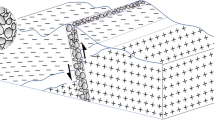Abstract
With the rapid development of underground construction, a large number of tunnels will be built at the positions where unprecedentedly complex geological conditions exist. It results in more and more tunnel water inrush accidents. Study on water inrush becomes more and more important. The water inrush in tunnel construction is the results of water–rock coupling interaction. The surrounding rock stress state changes continuously in tunnel excavation, so recording the data of stress, displacement and water pressure in the whole process is essential to the research of the tunnel water inrush mechanism. By the physical simulation experiment of water inrush in tunnel excavation, the change laws of stress, displacement and water pressure were analyzed: The displacement increased gradually at the beginning, but sharply increased when excavation reached the water-bearing structure; the stress concentrated in the early period and released later; the water pressure increased sharply firstly and stabilized afterward with slow but continuous decrease. The whole water inrush process can be divided into two periods: accumulating period and instability period. The accumulating period was characterized by the stable development with elastic potential energy and rock damage accumulating continuously, while the instability period performed state’s sudden changing. Based on the analysis above, actual engineering cases and cusp catastrophe theory, the criteria of water inrush were established and verified with the experimental data.










Similar content being viewed by others

References
Bu W, Mao X (2009) Research on effect of fault dip on fault activation and water inrush of coal floor. Chin J Rock Mech Eng 28(2):386–394
Chen H, Li X, Liu A et al (2010) Physical simulation modeling of roof water inrush in underwater mining. J China Univ Min Technol 39(6):854–859
Fei WP, Zhang L, Zhang R (2010) Experimental study on a geo-mechanical model of a high arch dam. Int J Rock Mech Min Sci 47(2):299–306
Feng MM, Mao XB, Bai HB et al (2009) Experimental research on fracture evolution law of water-resisting strata in coal seam floor above aquifer. Chin J Rock Mech Eng 28(2):336–341
Fumagalli E (1973) Geomechanical models. Statical and geomechanical models. Springer-Verlag Wien, New York, pp 152–180
Goel RK (2014) Tunnelling through weak and fragile rocks of Himalayas. Int J Min Sci Technol 24(6):783–790
Hu YQ, Zhao YS, Yang D (2007a) 3D solid-liquid coupling experiment study into deformation destruction of coal stope. J Liaoning Tech Univ 26(4):520–523
Hu YQ, Zhao YS, Yang D (2007b) Simulation theory and method of 3D solid-liquid coupling. J Liaoning Tech Univ 26(2):204–206
Jiang Y, Wang LS (2002) Problems of high stress rock burst and water outburst and countermeasures in deep and long tunnel. Chin J Rock Mech Eng 21(9):1319–1323
Li LP, Li SC, Chen J et al (2011) Construction license mechanism and its application based on karst water inrush risk evaluation. Chin J Rock Mech Eng 7:1345–1355
Li SC, Zhou ZQ, Li LP et al (2013) Risk assessment of water inrush in karst tunnels based on attribute synthetic evaluation system. Tunn Undergr Space Technol 38:50–58
Li LP, Lei T, Li SC et al (2014) Risk assessment of water inrush in karst tunnels and software development. Arab J Geosci 8(4):1843–1854
Li SC, Tian H, Xue YG et al (2015) Study on major construction disasters and controlling technology at the Qingdao Kiaochow Bay subsea tunnel. J Coast Res 73(s1):403–409
Liu J, Feng XT, Ding XL et al (2003) Stability assessment of the Three-Gorges Dam foundation, China, using physical and numerical modeling-part I: physical model tests. Int J Rock Mech Min Sci 40(5):609–631
Shen XM, Liu PL, Wang JF (2010) Evaluation of water-inrush risks of Karst tunnel with analytic hierarchy process. J Railw Eng Soc 12:56–63
Yang YT, Li KK (1997) Water inrush mechanism in coal seal floor by the physical analogy simulation technique. Coal Geol Explor 25(S1):33–36
Zhang XH, Liu QW (2005) Analysis of the features of water outbursts from underground rivers and the countermeasures in Wulong tunnel. Mod Tunn Technol 42(3):59–63
Zhang QS, Li SC, Han HW et al (2009) Study on risk evaluation and water inrush disaster preventing technology during construction of karst tunnels. J Shandong Univ (Eng Sci) 39(3):106–110
Zhao Y, Li PF, Tian SM (2013) Prevention and treatment technologies of railway tunnel water inrush and mud gushing in China. J Rock Mech Geotech Eng 5(6):468–477
Zhao YL, Peng QY, Wan W et al (2014) Fluid–solid coupling analysis of rock pillar stability for concealed karst cave ahead of a roadway based on catastrophic theory. Int J Min Sci Technol 24(6):737–745
Zuo JP, Chen ZH, Wang HW et al (2009) Experimental investigation on fault activation pattern under deep mining. J China Coal Soc 34(3):305–309
Acknowledgments
The authors wish to acknowledge the following funding for supporting this study, it is the State Basic Research and Development Program of China (No. 2013CB036003). Special thanks to Wang Yin and my partners who collected data in the experiment.
Author information
Authors and Affiliations
Corresponding author
Rights and permissions
About this article
Cite this article
Liang, Dx., Jiang, Zq., Zhu, Sy. et al. Experimental research on water inrush in tunnel construction. Nat Hazards 81, 467–480 (2016). https://doi.org/10.1007/s11069-015-2090-2
Received:
Accepted:
Published:
Issue Date:
DOI: https://doi.org/10.1007/s11069-015-2090-2



